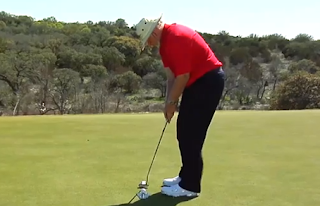Over the last two years I have learnt a lot about the golf swing from Sean Hogan. He has acted as David Leadbetter assistant for the last twenty years working with the likes of Nick Faldo, Ernie Els and Nick Price. Today he coaches a number of top players in his own right to include Suzanne Petterson and Fredrick Jacobson.
An area of the swing he has really helped me to understand is concerning shoulder alignment at impact. There appears to be two distinct shoulder alignments commonly seen in great ball strikers, one where the shoulders are square or parallel to the intended target line the other where the shoulders are open or looking left.
As a general rule if the player prefers to fade the ball a slightly open shoulder pattern is going to be more desirable and to draw the ball the opposite. The key is to match the players standard ball flight preference with a swing plane, shoulder alignment and release that complement one another.
1. Open pattern/ Open shoulders at impact
The open shoulder position is usually more associated with a fade and an in to out club movement. It is common to see players with open shoulder alignments at impact to have a relatively strong grip.
Tour players tend to match their body rotation through impact with their grip. I have observed that usually the more open the chest at impact the stronger the left hand grip of the player and as a result you will tend to see the face looking relatively down coming into impact with an open and active chest. These players will then use a release often referred to as the under release or stable release. The release of the golf club is often misunderstood and many think to square the club face at impact there must be some rolling of the forearms through impact in order to square the face. The reality is that many great ball strikers actually try and feel the opposite and reduce forearm and wrist rotation to a minimum.
Many believe that in order to implement an open shoulder alignment at impact they need to overly lean the shaft or hold off the release but this just isn't the case. The key is to remain a high body speed through impact as it is the speed of the pivot and the chest in the downswing that is actually holding the face open. The faster the pivot the more this effect occurs. If the body begins to slow up through impact the face will close causing shots to the left.
In the best ball strikers the more you see the club passing the hands through impact the less rolling will occur and vice versa. I was taught at a very young age by my first coach and European Tour winner Peter Mitchell that you are best to have a grip that is a little to strong than weak. David Leadbetter is certainly an advocate of this as their have been very few great ball strikers throughout history that have had overly weak grip. As a general rule a stronger grip allows for less face rotation through the impact interval. The more the club face is rotating through impact logic would say the harder it is to return to the same position.
If we were to refer to putting for a minute there appears to be a strong relationship between the ability to start the ball consistently on line and the amount of rotation in the clubface through impact and I see no difference in the golf swing.
2. Square shoulder position at impact
If you prefer a squarer shoulder position you will want a slightly weaker grip and to adopt more of a roll release. This is a release where the club face goes from more of a toe up position in delivery or where the shaft in horizontal to the ground coming into impact and then rotates to mirror the position in the through swing.
In order to give the club time to square a larger forward or lateral movement of the hips is required in the downswing with the hips rotating slower. The shoulder position at impact is a key determinant on club path and so we tend to see more of an into out path and a draw ball flight.
With this type of body alignment it is going to be difficult to consistently fade the ball with the resulting shot type often a push fade.
In my coaching if I see a player with a very fast natural pivot I tend to work with this as much as I can and would teach a more open shoulder alignment if a player has a much slower pivot a more closed shoulder position may suit.
When developing players I tend to lean towards a more open shoulder alignment at impact with modern technology I feel I can create more power and consistency on average in my students. I believe in a swing where a lot of the force in the swing is created with chest speed over a lateral then turning supportive hip segment. Too much hip speed makes synchronisation extremely difficult and even though for the amateur they would love to be able to activate this area more the the elite golfer it is usually the opposite.
Thanks for Reading
Matt




















Follow Us
Were this world an endless plain, and by sailing eastward we could for ever reach new distances